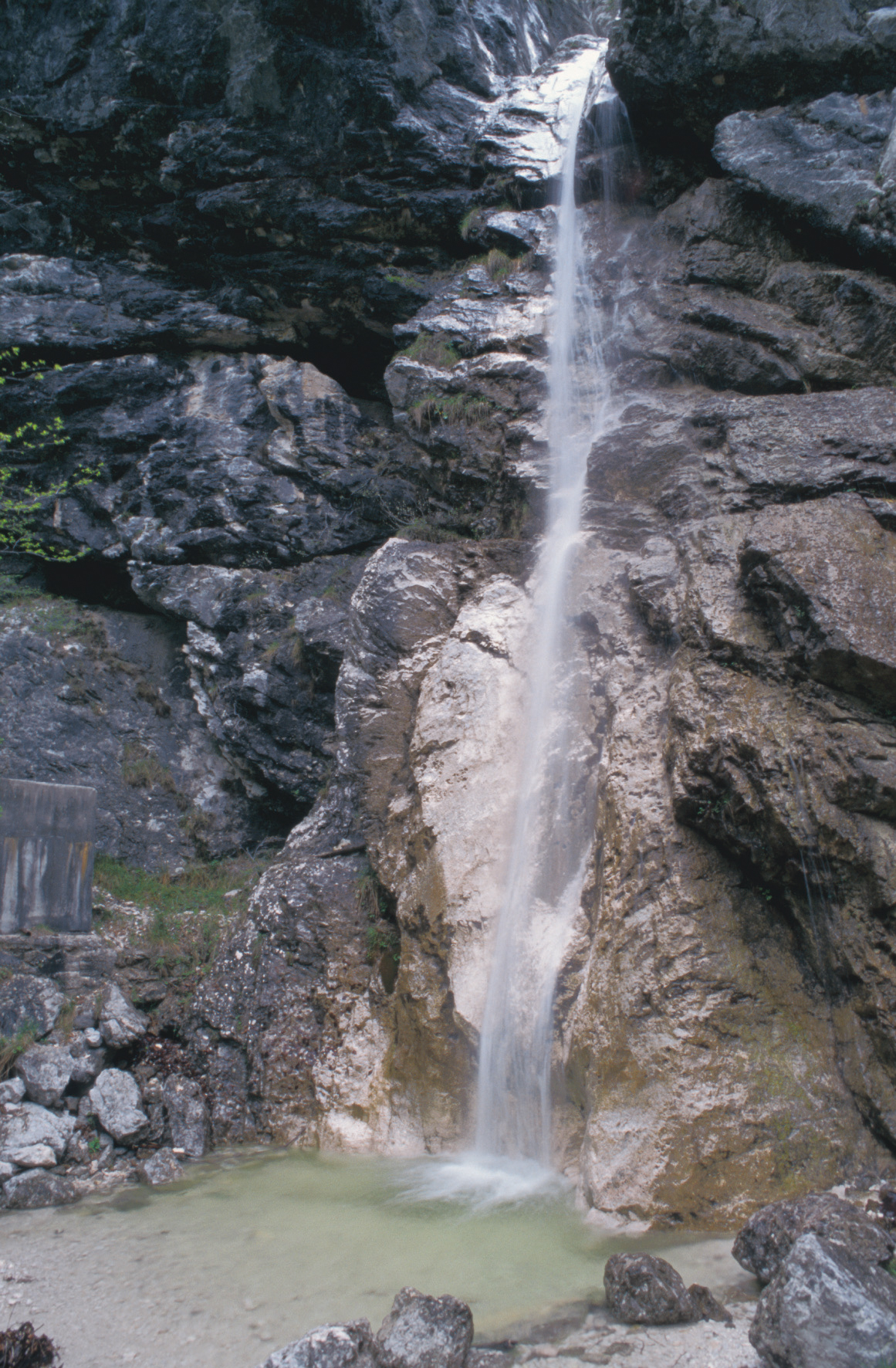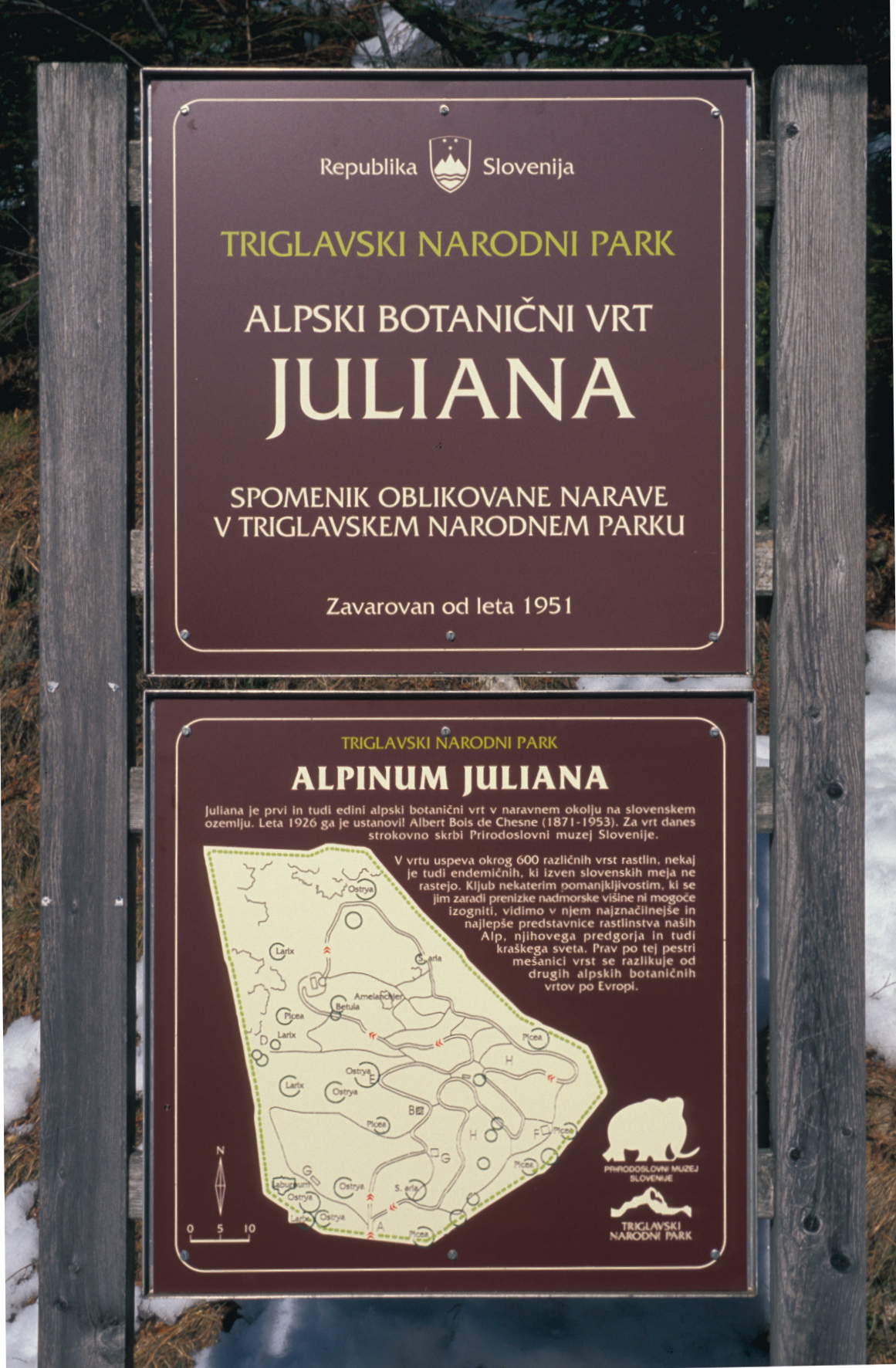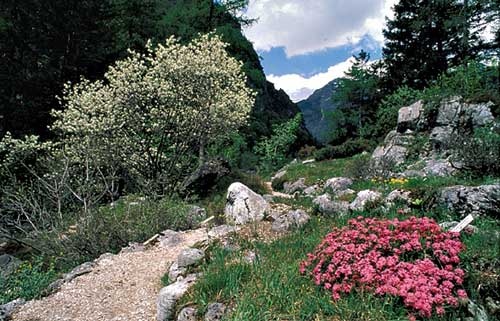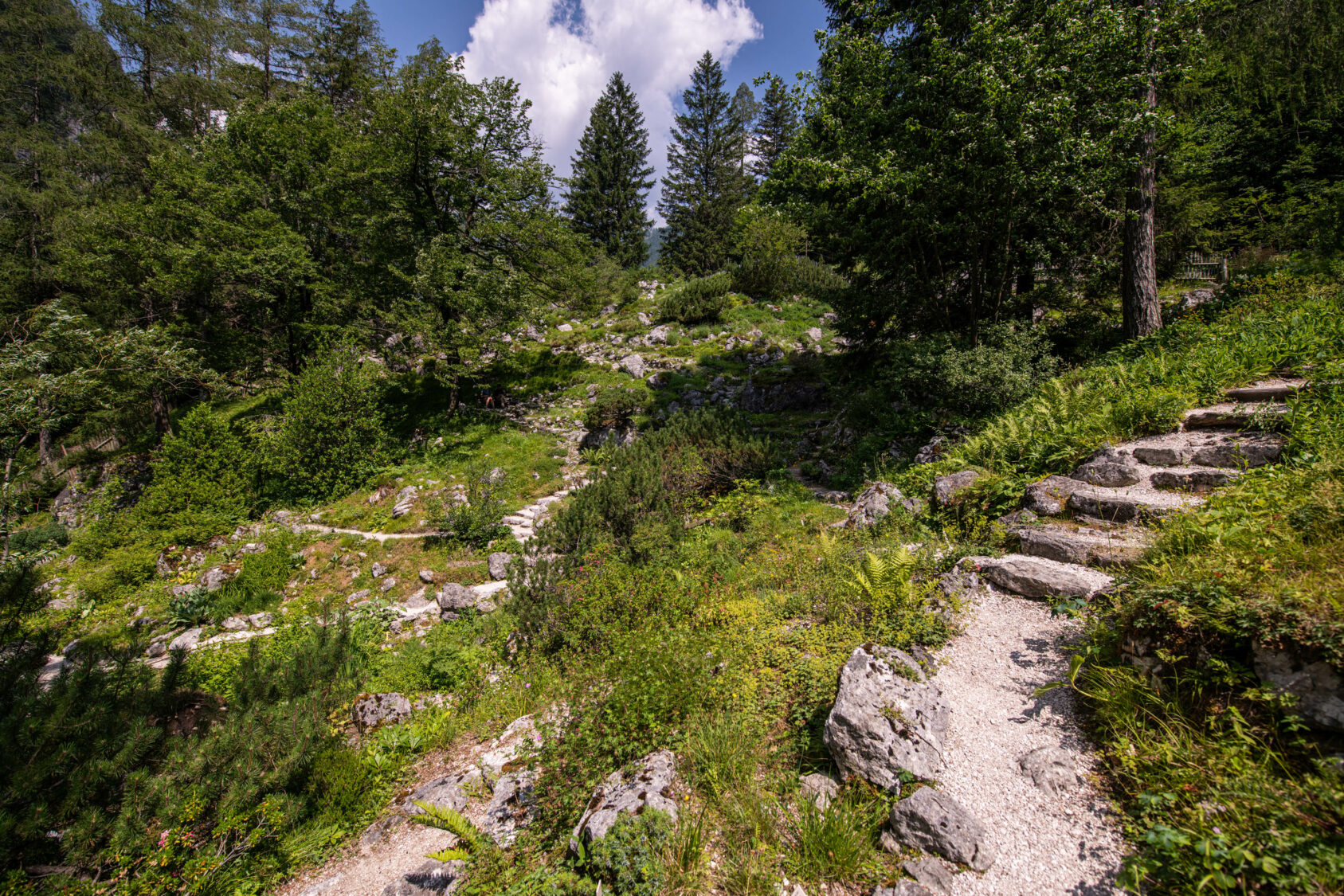Juliana is the oldest Alpine botanical garden in a natural environment in Slovenian territory. It was founded in 1926 by Albert Bois de Chesne (1871-1953), a proprieter from Trieste. He was counselled by his mountaineering friend Julius Kugy. A walk through the garden was meant to be a walk from the valleys to our mountain peaks.
History
Albert Bois de Chesne chose his site on Tožbar’s land, 50 metres above St. Mary’s Church, where the Soča River runs 30 metres below. At an altitude of 800 metres, the site lay on a slope of Mt Kukla, and measured 2572 square metres in extent. Thanks to the humidity, light and shade, shelter from the winds, variegated tarrain, and scattered rocks of different sizes, this piece of land was most suitable for his intentions. Several trees already grew there: spruces, larches, white beeches, small ashes, and beeches. The land was cleared and a few of the trees cut down. As there was no water source in the Garden, a reservoir was put in below the waterfall on the slopes of Mt Kukla, pipes installed, a cement cistern built, and from there water was drawn through pipes into the Garden. Now it only needed to be enclosed and by autumn the of 1926 all the preliminary work had been done. During the winter, Bois de Chesne studied works on the Julian alpine flora; in the spring of 1927 he undertook the field work. He began to bring specimens from the mountains and transplanted them into the garden. The plants, after they had been cleaned at their sites of origin, were brought in knapsacks and baskets individually wrapped in damp moss. Bois de Chesne tried to create environmental conditions similar to those of the natural environment for the plants, basing the Garden on the achievements of the biological and geographical sciences. Kugy had stated that a garden should represent a botanical journey from the valley onto some Julian peak and that the vegetation belts should succeed one other just as in nature. Thus, the fence at the lowermost part was surrounded by valley flora, while higher up the land was planted with the high alpine flora of the undergrowth found in beech and spruce forests; the damp-loving marsh marigolds and butterworts surrounded the trough, and above were the tall plants and the dwarf pines; just under the peak there were stone crevices and screes where the high alpine flora was given its niche.
Albert Bois de Chesne took great pleasure in his garden, although he also had many disappointments. He transplanted ferns carefully, but by no means did they want to flourish, and it was only when he used roofing paper to separate the ferns from neighbouring tree roots that he stopped them from withering away. There were difficulties with plants that preferred to grow in acidic soil. Bois de Chesne’s workers had to remove a part of the limestone undersoil, lay down two layers of roofing paper, followed by porphiry and rocks from the Werfen layer at Rabelj, while the soil was unmodified humus, dug from under dwarf pines at an elevation of 1600 metres, and mixed with peat. Those plants known to be acid-loving were watered with rain water only.
The majority of the plants in the Garden were brought from the eastern and western Julian Alps, the Friuli hills, the Karst meadow, and the prealpine world; a few were from the Karawanken and Kamnik Alps. To the left of the entrance, plants of foreign origin obtained from the Western Alps, the Pyrenees, the Apennines, the Atlas, and Caucasus, were planted.
Bois de Chesne chose one of the Tožbar family, Anton, as the gardener, a grandson of “Death-of-a-Bear” and sent to him to school in Padua (Italy). Later he was helped in the Garden by Ančka Kavs. Both remained faithful to Juliana for many years after the Second World War, when its founder could no longer visit it.
The Founder
Albert Bois de Chesne was born on July 8, 1871, in Trieste, a descendent of a Huguenot family which had moved to Switzerland from France. In Trieste, where he attended secondary school, his professor was Edward Pospichal.
Juliana after 1945
During the Second World War and for some years following, the Garden was essentially left unattended. Until 1947 Bois de Chesne payed monthly stipends for at least minimal care, and Anton Tožbar and Ančka Kavs tended it to the best of their abilities.
The gardeners
When we speak of the Garden, two names necessarily come to mind: Anton Tožbar and Ančka Kavs. Both are closely connected to the Garden’s history.
Many probably still remember the quiet, modest, little woman who tirelessly cared for the flower beds, watered the plants, enthusiastically told the visitors about her favourites, and pointed out hidden treasures. Ančka Kavs was born on December 28, 1907, at Vrsnik into a large family. She was glad to accept Bois de Chesne’s offer when he needed a gardener in Juliana. She died on March 6, 2000.
Who has not heard of the “Death-of-a Bear”, of Anton Tožbar-Špik, Kugy’s guide? His son was Albert Bois de Chesne’s game keeper and his grandson a gardener in Juliana. He was born on May 29, 1905, in Trenta. Juliana grew on his soil, and he was therefor closely connected to it all his life, not only professionally but also emotionally. He walked the mountains, dug plants, and carefully carried them into the valley. He remained faithful to the Juliana Garden after the Second World War; even when retired he was glad to help by working and advising. He died in Trenta on February 3, 1993
The work of the first two gardeners was continued by Tožbar’s daughter Marija and her husband Jože Završnik (April 24, 1946 – November 3, 2005) and now their youngest son, Klemen, are following the family tradition.
Juliana today

The waterfall Skok Za Bajto cascading down Mt Kukla. Photo: C. Mlinar
Where spring begins earlier
Albert Bois de Chesne had worked to organize the Garden on an ecological basis, by associations, so that each individual flower bed would represent a cross-section of the natural environment, while the entire Garden would be a colorful mosaic of the flora of our Alps. We have already mentioned the difficulties he had. The strong influence of the Mediterranean can be felt throughout the Soča valley as its climate is much milder than in Kranjska Gora on the other side of Vršič. The submediterranean flora extends far into the interior of the Julian Alps.
Even the location of Juliana itself, lying on the southern slope of Kukla, offers far better conditions for karstian plants than for the high alpine flora. Much work and love were necessary to bring Juliana to life and to keep it flourishing. We can hardly imagine how difficult it was to transplant the modest little plants, used to a bare handful of soil in rocky crevices and to the bitter spring winds, into Trenta, onto a windless slope, where spring started a month or two earlier. In such a garden it was necessary to create an environment similar to their natural habitats.
Despite all efforts, many plants do not flourish because of the drought in summer, while during the past few years the snowless winters have had an adverse effect. Perhaps the plants do not like the soil, and sometimes they are displaced by competitors. The king of the Alps, a cushion-forming plant with pale blue flowers, and the moss campion usually cease to flourish after one year. Their sites are rocky crevices and gravel just below the mountain peaks, so it is understandable that they find it difficult to acclimate to an altitude of only 800 meters. Other less sensitive plants survive several years, while others still undergo changes. The white of the edelweiss turns pale green in a few years. The Triglav cinquefoil whose large flowers remind us of the Zlatorog’s bloody trail only rarely blooms in the Garden.
Index seminum
Most of the flowers are perennials while a few are annuals or biannuals. These are taken care of in the nursery. The gardeners patiently gather seeds which they plant in this Garden. Thus, they avoid carrying a large number of new plants from the mountains every year. Some perennials are also started from seeds. A portion of the seeds are sent to the Ljubljana Botanical Garden which every year publishes the Index Seminum, including the list from Trenta. Seeds are also sent to other botanical gardens around the world in exchange for others.
The only alpine garden in Slovenia
Juliana is the first and only alpine garden in Slovenia. Despite some deficiencies that cannot be avoided, it does contain the most characteristic and most beautiful examples of the flora of the Slovene Alps, foothills, and the karst.
The Garden is not only meant for botanists who study flora professionally but particularly for people who love the mountains and the outdoors. Only they will know to stop at a minute blossom of Zois’s bellflower or by the cushions of the “squarrose saxifrage”. Many who come by chance in July or August, still all agog at the colorful meadows of Kriški podi or Sleme, will be disappointed. Although high in the mountains the summer has barely begun and only the earliest plants have flowered, in the Trenta valley the visitor is greeted by the first harbingers of the fall. The majority of these visitors give a cursory look at the flower beds and barely stop for a moment at the belvedere where they do not even notice the rare blossoms of the Triglav cinquefoil. Then they hurry onwards, perhaps to the sea, perhaps to collect a new stamp (a collector’s item from mountain huts). Truly, Juliana is at its most beautiful in May and the beginning of June, when the primroses and gentians are in bloom, and a little later the daphnes, the saxifrages, dianthuses, and rhododendrons. However, there are many other small, perhaps less noticeable plants that are equally beautiful and worthy of the visitor’s attention.

Information panel by the road at the entrance to the Juliana Garden. Photo: C. Mlinar

Photo: Ciril Mlinar Cic
Plan your visit
Juliana is open from May 1 to September 30.
Information about location, entrance fee, and programs.
More information
T: + 386 1 241 09 40
F: + 386 1 241 09 53
E: uprava@pms-lj.si
Juliana Alpine Botanical Garden
Naravni spomenik Trenta- Alpinum Juliana
5232 Soča
Slovenia
